Exploring Colorwork Crochet: Tapestry, Fair Isle, and Intarsia Techniques Compared
A journey into the world of colorwork can be both exciting and a tad overwhelming, especially for those new to crochet.
Fear not, because this article is your guide to unraveling the very basics between tapestry, Fair Isle, and intarsia crochet colorwork.
These techniques might sound like a mouthful, but they’re the keys to transforming your crochet projects into vibrant works of art.
Whether you’re a beginner eager to dip your toes into the colorful waters of crochet or an experienced crocheter looking to expand your skills, I’ll walk you through the basics and differences of each colorwork technique.
If you’re wondering…
- What is colorwork crochet
- How do you crochet intarsia?
- What is the tapestry crochet stitch?
Grab your crochet hooks and let’s explore the captivating realm of colorwork together!
This article may contain some affiliate links.
Table of contents
Estimated reading time: 9 minutes
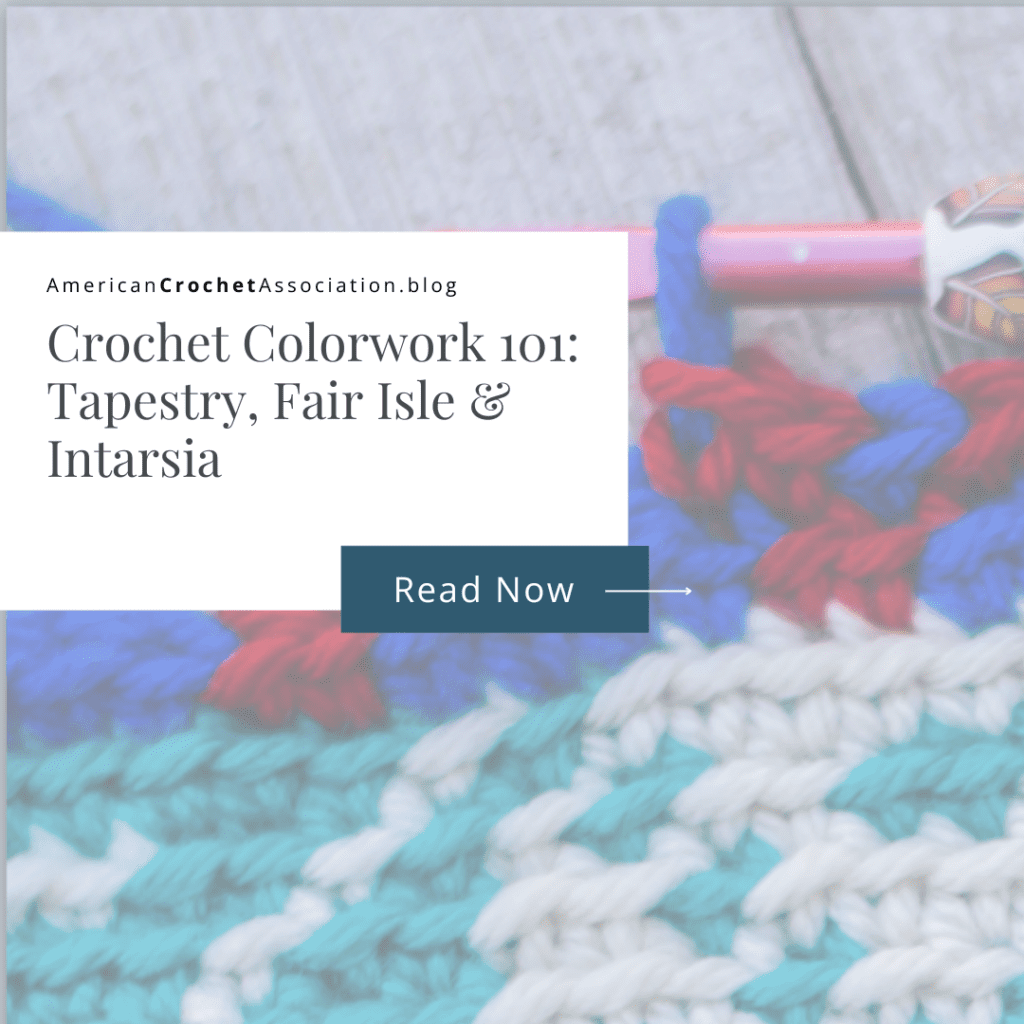
What is crochet colorwork?
Crochet colorwork is a technique in which multiple colors of yarn are used to create intricate patterns, designs, or images within crochet fabric.
Colorwork involves working with two or more colors in a single row or round to achieve a desired visual effect, adding depth, texture, and vibrancy!
Alternating color in crochet can be used simply to create stripes in rows or rounds.
And, there are simple techniques we can use to create the intricate and colorful designs we see in crochet fabric (otherwise known as Crochet Colorwork).
Colorwork methods are just color-changing techniques, specifically when it comes to what is done with the unused color of yarn.
Types of Crochet Colorwork
There are several methods of crochet colorwork, each with its own uniques characteristics and approaches.
Some of the most common crochet colorwork techniques include:
- Fair Isle
- Tapestry
- Intarsia
When looking at the right side of a fabric, each of these colorwork techniques might look very similar.
The difference between each type of colorwork is how the unused yarn colors are managed when they are not in use, and the most common are:
- carrying yarn,
- crocheting over yarn,
- fastening off yarn.
Depending on the project, stitches, number of colors used, and fabric you want to create, these techniques may be interchangeable to fit your needs.
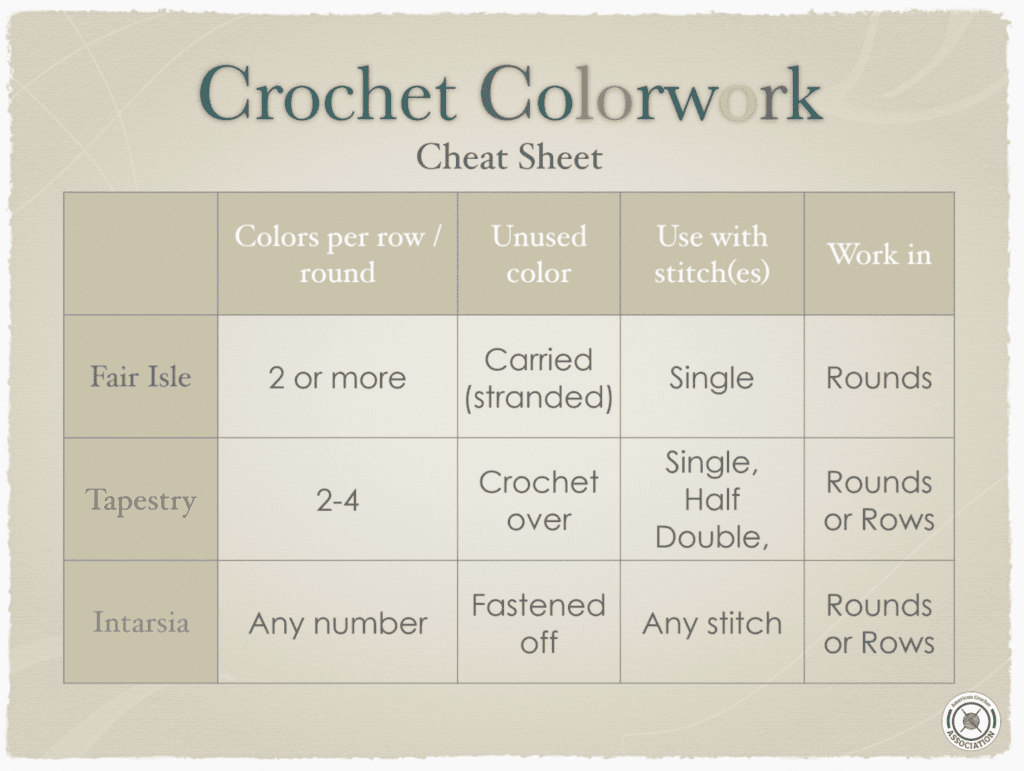
Reading Colorwork Graphs
Most colorwork in crochet is created with basic stitches of solid fabric, and the color changes are what create the intricate designs in the fabric.
Therefore, colorwork is sometimes easiest to read and follow when looking at a color coded graph.
On a graph, one square represents one stitch.
Each square color on the graph represents the color changes you must make in your stitches to create the same type of colorwork fabric.
To read and follow a colorwork graph, begin at the bottom row (on the right if you are right handed, and the left if you are left handed), then work upwards.
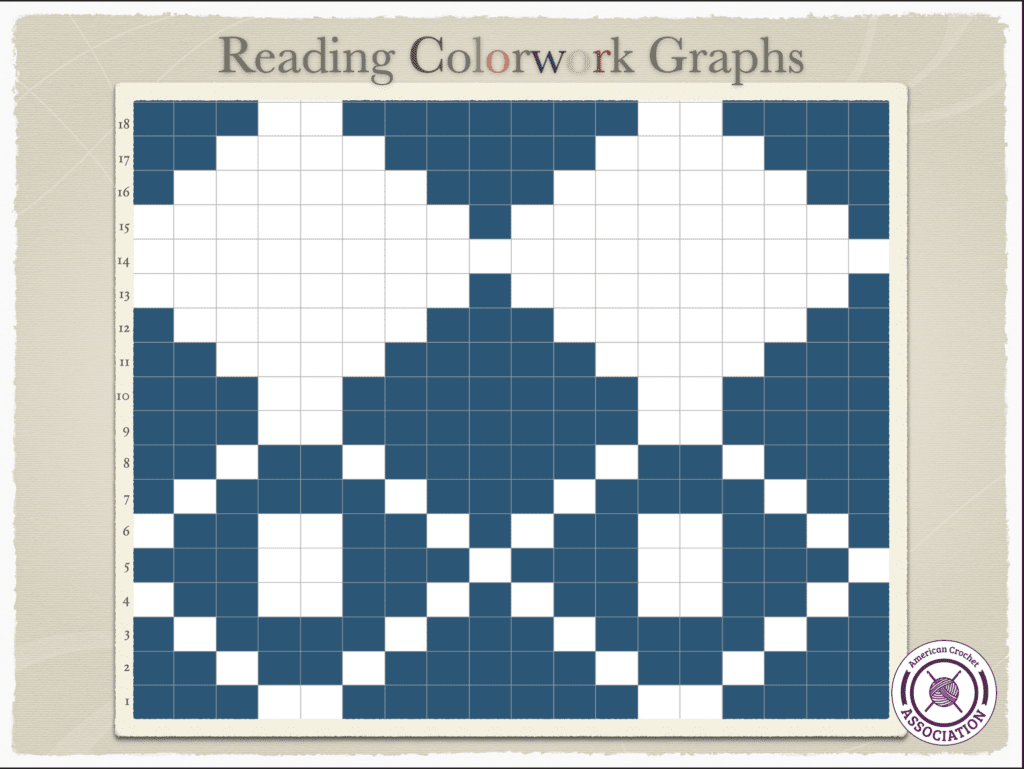
Fair Isle
According to Wikipedia, the term “Fair Isle” originates as a knitting technique, taking its name from an island in the Shetland region of Scotland.
Fair Isle crochet and Fair Isle knitting are two different techniques for creating colorwork patterns, but they share a similar visual style.
The main difference lies in the crafting tools and techniques used.
In this technique, the unused colors float along the back of the fabric until they are needed again and picked up.
In this example, the left shows the front of the fabric and the right shows the back of the fabric.
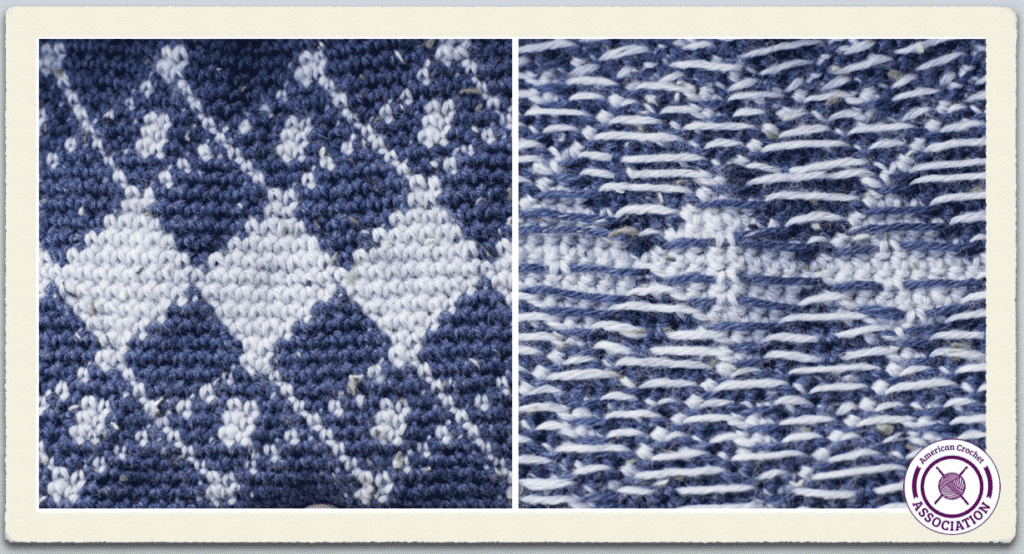
About Fair Isle:
- Because long strands are left on the back, this is also known as “stranded” colorwork.
- Only one color is used at a time, so this method produces very clean color changes.
- This method is usually only used with single crochet.
Fair Isle Tips:
- To avoid long strands behind your work that can snag or pull, work over unused strands after every few stitches.
- This method is best worked in rounds, hiding the “stranded” or wrong side of the fabric.
- Consider the contrast between colors to ensue that the pattern stands out clearly.
- Fair Isle crochet floats (strands) should be slightly looser than regular stitches to prevent puckering.
- For longer color changes, it may be better to fasten and rejoin the yarn (Intarsia) rather than carry it too far across the back. This prevents long floats (strands) that can cause the fabric to pucker.
Fair Isle Crochet Books
To learn more about Fair Isle Crochet, check out these books:
Melissa Leapman – Fair Isle Crochet Projects: 8 Traditional Projects using Fair Isle Technique
Karen Ratto-Whooley – Learn To Fair Isle Crochet
Tapestry
Tapestry crochet is a technique that involves creating colorwork patterns by carrying multiple colors of yarn within each row or round of crochet.
It creates a fabric with a woven appearance, similar to tapestry weaving.
In this technique, the unused colors are crocheted over (working them into your fabric) until they are needed again and picked up.
In this example, the left shows the front of the fabric and the right shows the back of the fabric.
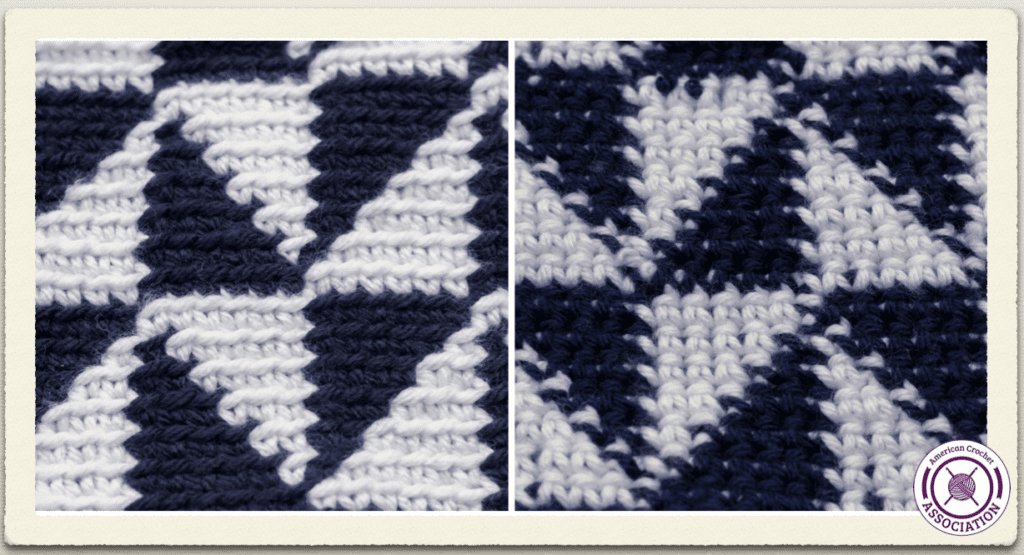
About Tapestry:
- Small stitches (single) create a tight space for the yarn that is carried (crocheted) over, which also creates a tighter, more dense fabric.
- While more than 2 colors can be used per row, each strand thickens the fabric.
- The fabric has a right side, but the wrong side doesn’t have to be hidden (like Fair Isle).
Tapestry Tips:
- This technique can be worked in rows or rounds.
- While single crochet is mostly used, other stitches can be used with this technique.
- Use yarn with similar weights and textures to ensure consistent tension throughout the project.
- Keep your tension even when working with multiple colors, and avoid pulling too tightly on the carried yarn to prevent puckering.
Tapestry Crochet Books
To learn more about Tapestry Crochet, check out these books:
Brenda K.B. Anderson – The Hooktionary: A crochet dictionary of 150 modern tapestry crochet motifs
Alessandra Hayden – Modern Tapestry Crochet
Intarsia
Unlike techniques such as tapestry crochet or Fair Isle crochet, where colors are carried along the back of the work or crocheted over into the fabric, intarsia crochet involves dropping (fastening off) and picking up (reattaching) different colors of yarn as you need them.
Because color changing happens frequently, proper tension management is important to maintain an even fabric and prevent loose or puckered stitches at color changes.
This technique uses as many strands (colors) of yarn as you like, because each one is picked up and fastened off as needed.
Intarsia crochet is particularly suited for creating larger areas of color; It allows for intricate color placement without the need to carry multiple colors across the work.
To facilitate the color changes, bobbins or small balls of yarn are often used for each color block; this helps prevent tangling and makes it easier to work with multiple colors.
In this example, the left shows the front of the fabric and the right shows the back of the fabric.
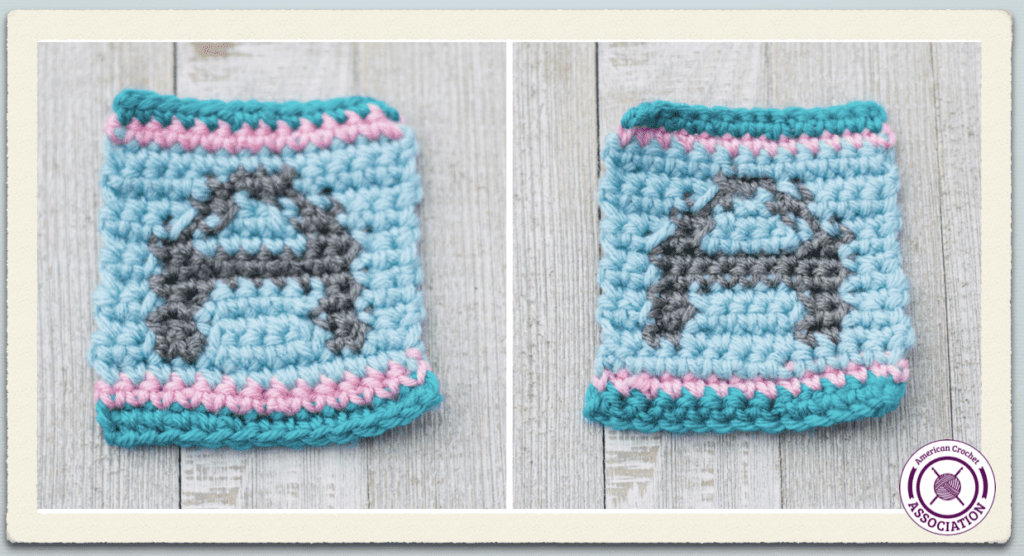
About Intarsia:
- Intarsia is reversible (the front and back of a fabric look similar). This is because yarn ends are sewn into the same color fabric to hide and secure.
- This is usually worked in single crochet, but is also possible in half double, double, Tunisian, and corner-to-corner.
- There is no limit to the number of colors you can use (each color change is fastened off as you go).
Intarsia Tips:
- When working with multiple colors in intarsia, bobbins or separate balls of yarn for each color block can help keep things organized. This is because every color change is fastened off (creating two tail ends).
- Intarsia leaves a lot of ends to weave in (two per color change). Sew them in as you work, especially to keep your fabric tidy.
- Before starting a row, identify where color changes will occur to help manage your yarns efficiently.
Intarsia Crochet Books
To learn more about Intarsia Crochet, check out this book:
Laurinda Redding – Reversible Color Crochet: A new technique
Tips when making colorwork fabric
Crochet colorwork requires careful tension management to ensure that the fabric remains even and doesn’t pucker or distort.
Beginners to crochet, and to colorwork techniques, might find it helpful to start with simpler colorwork patterns before gradually progressing to more complex designs as they become comfortable with the techniques.
Also, creating small swatches with each of the different types of colorwork can help to practice the color changing technique, and the tension of your fabric.
You can learn more about creating swatches in crochet right here: https://americancrochetassociation.blog/how-to-crochet-a-swatch/
Colorwork Crochet Resources
Working tapestry, Fair Isle, and intarsia crochet colorwork techniques can be both rewarding and challenging.
Ultimately, these are color changing techniques that will take practice to polish your stitch work.
Here are some helpful tips to keep in mind while working with these techniques:
Change color in rows: Tutorial
Learn how to change colors in rows with this video tutorial:
Change color in rounds: Tutorial
Learn how to change colors in rounds with this video tutorial:
Colorwork Crochet Pattern Inspiration
Try a colorwork technique today from our Pinterest board, right here: https://www.pinterest.com/americancrochetassociation/crochet-colorwork/

Colorwork Cheat Sheet
Get a 20 page colorwork crochet guide that covers everything in this article about Fair Isle, Tapestry, and Intarsia crochet.
This huge guide can only be sent by email, just request one today!
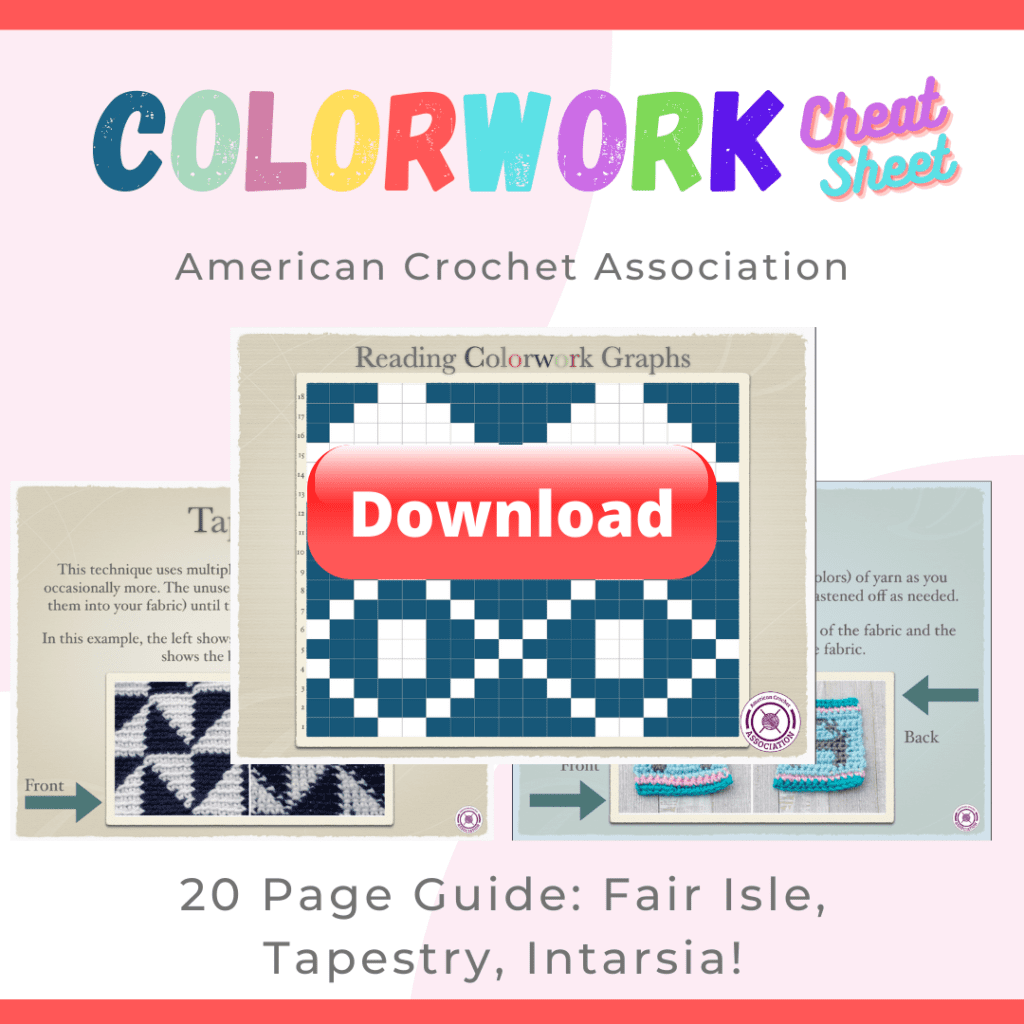
Click Here to share your new stitch skills in our community!
Peace + Love + Crochet
Salena

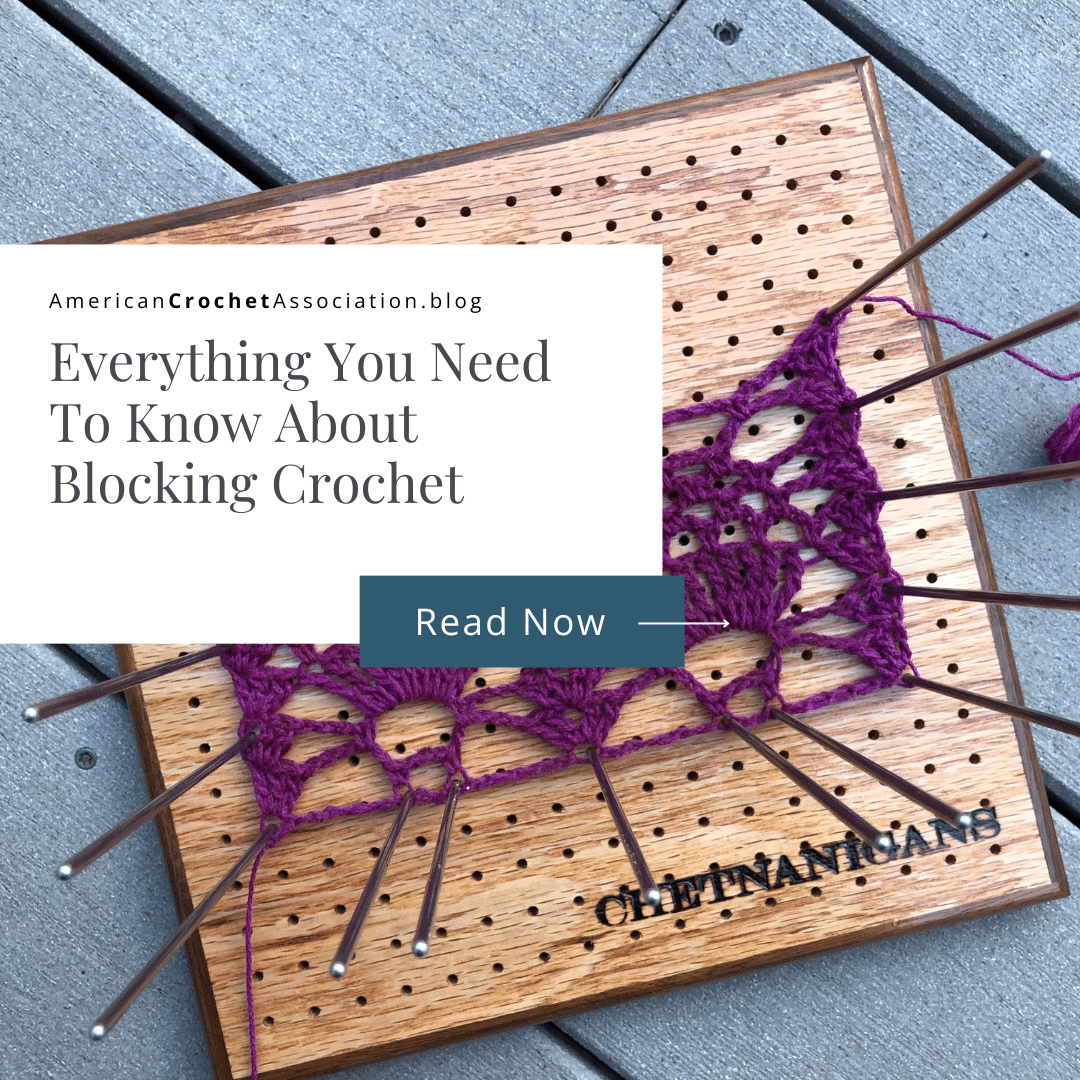
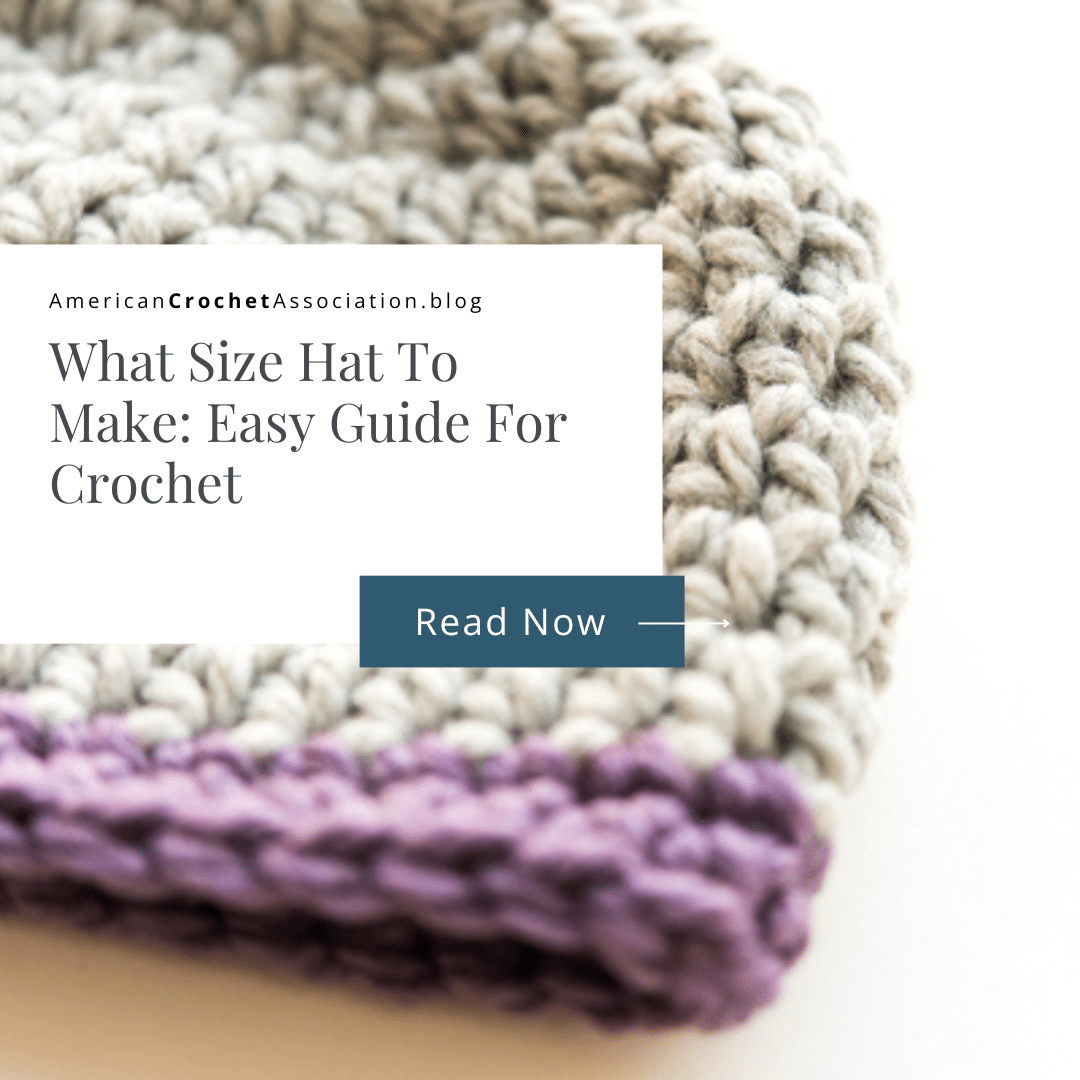

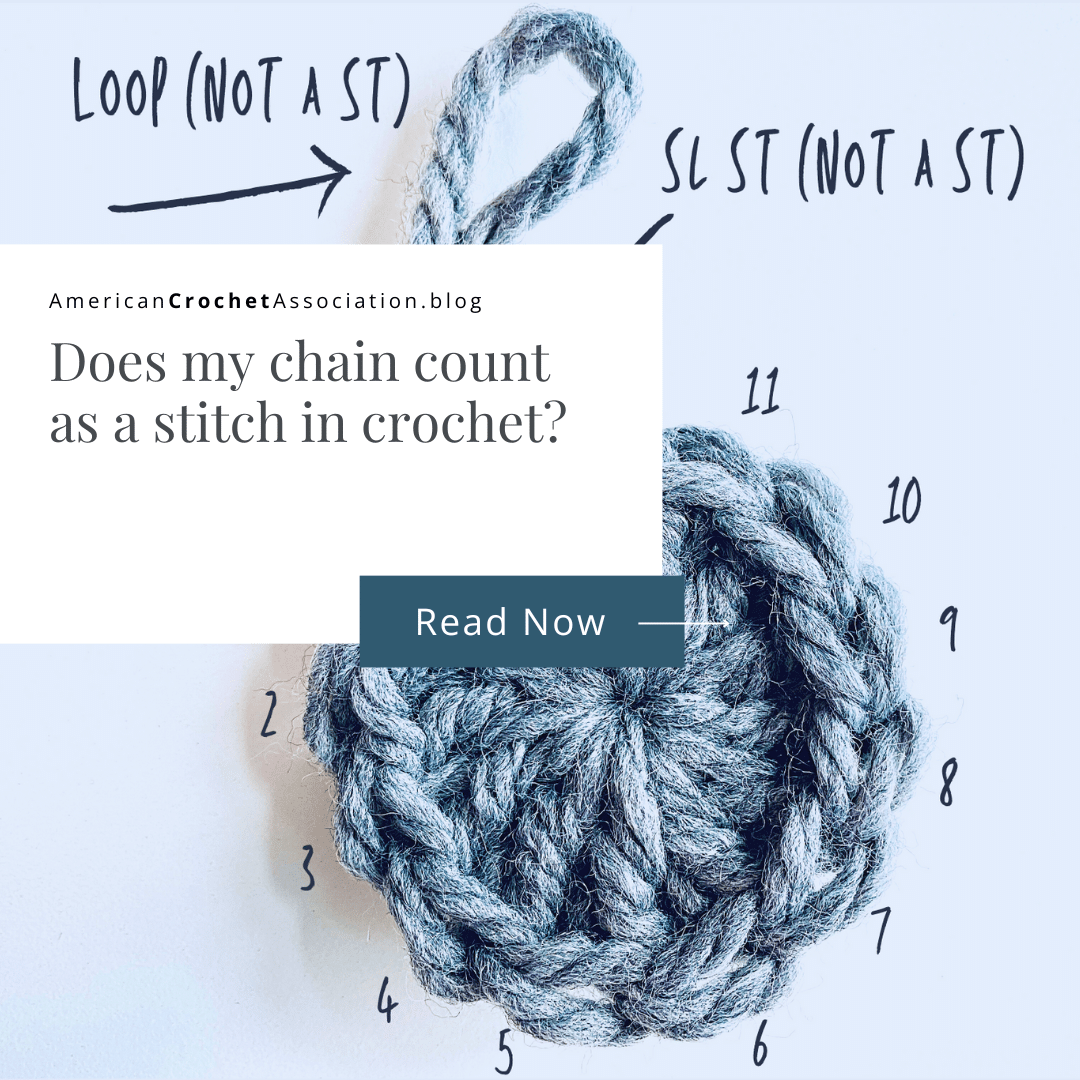
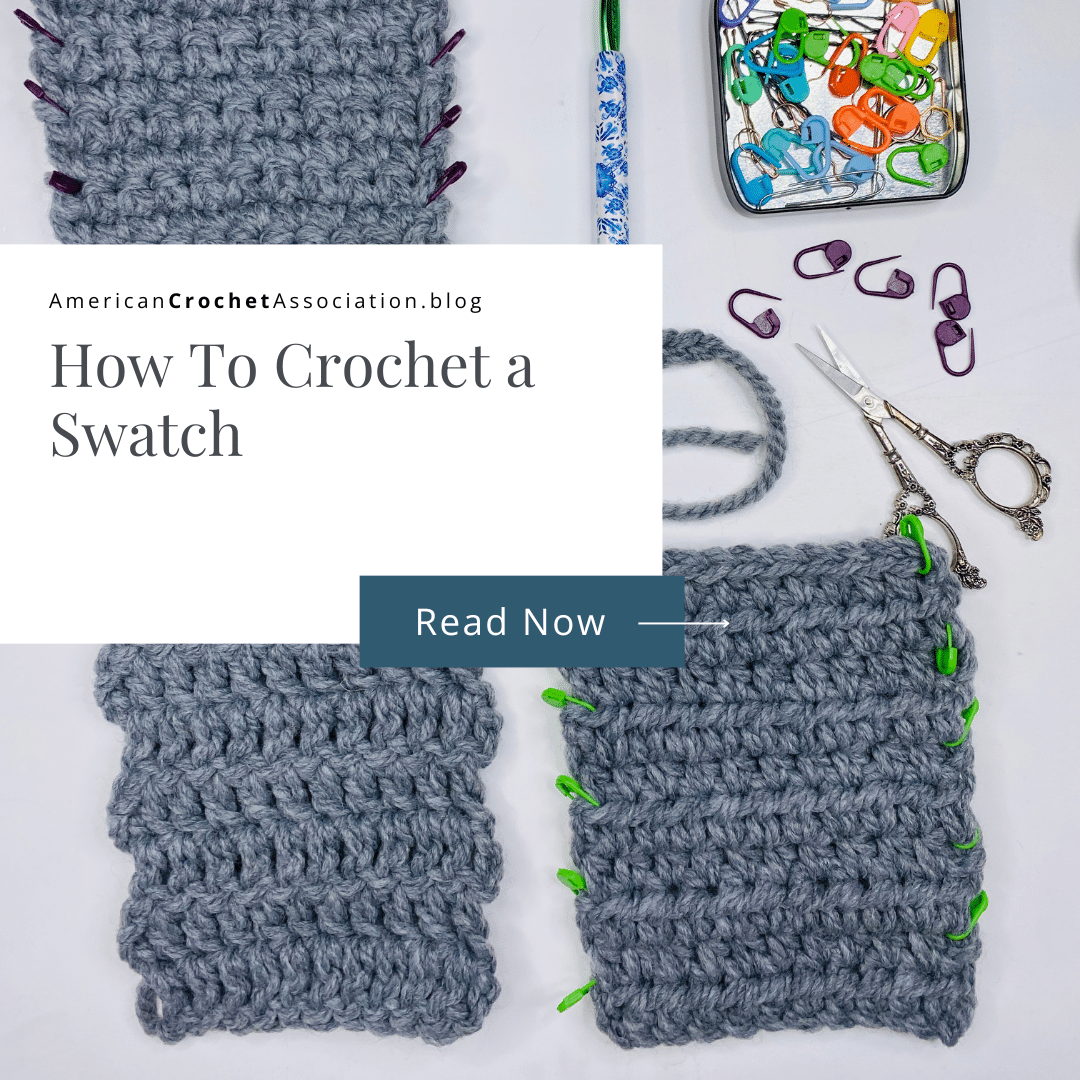
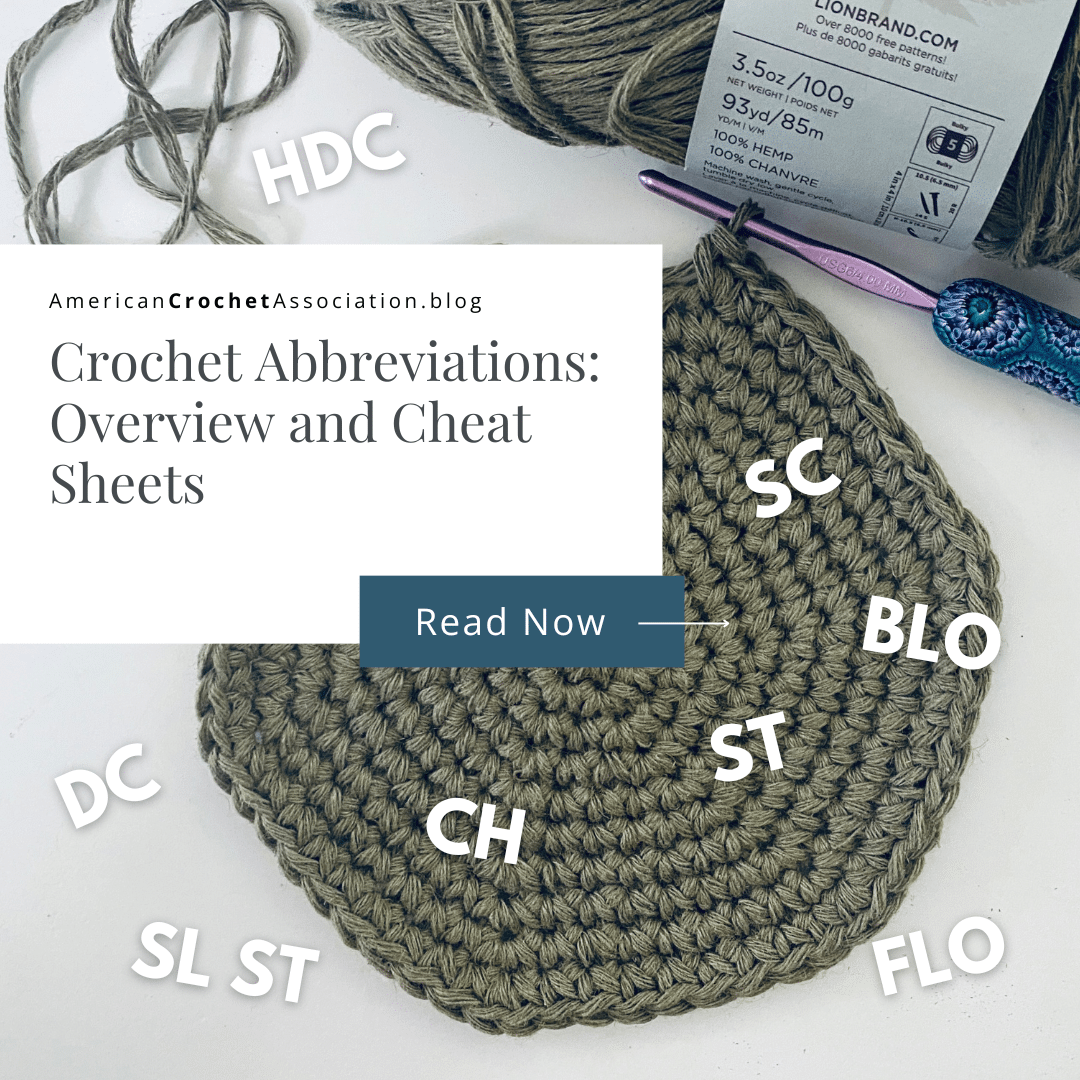
Hi Salena
I was just wondering where would pooling (argyle patterning) fit in, as there is only one skein of yarn, but in a sense it’s still color work.?
Fantastic question, thank you for asking! Pooling is a colorwork technique of its own entirely; it can only be produced using specific dyes and in a specific type of stitch pattern. I did not add Pooling to this article because you’re not using more than one color (strand) of yarn to create it.